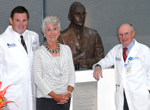|
by Melissa Lacas
Public Relations
As students, faculty, staff and patients enter the Ashley River Tower
(ART) atrium, they will now pass by a bust of Horace Smithy, M.D., an
open-heart surgery pioneer who changed the face of MUSC and cardiac
health care.
“The story about MUSC’s Dr. Horace Smithy is truly remarkable and
inspirational,” Fred A. Crawford, M.D., Division of Cardiothoracic
Surgery said. “He was one of the earlier pioneers for heart surgery and
heart disease of the mid-1940s and helped create the valvulotome used
during open heart surgeries.”
 Department
of Surgery's Dr. John Ikonomidis, Dr. Smithy’s daughter, Rosalie
Bradham, and Dr. Fred Crawford stand next to the Smithy bust located in
the ART atrium. Smithy’s family endowed a visiting professor chair in
his name at MUSC and then a chair in surgery—The Horace Smithy Endowed
Chair in Surgery. Crawford was the first recipient of the Horace Smithy
Chair (1997) and continues to hold it today. Department
of Surgery's Dr. John Ikonomidis, Dr. Smithy’s daughter, Rosalie
Bradham, and Dr. Fred Crawford stand next to the Smithy bust located in
the ART atrium. Smithy’s family endowed a visiting professor chair in
his name at MUSC and then a chair in surgery—The Horace Smithy Endowed
Chair in Surgery. Crawford was the first recipient of the Horace Smithy
Chair (1997) and continues to hold it today.
In honor of Smithy’s accomplishments, a bust was created and placed in MUSC’s main hospital.
“His bust has been part of our institution for 18 years as I would talk
about his achievements to medical students,” Crawford said. “In the
late 1980s, a group of medical students, along with several medical
departments, initiated the commissioning of his bust to be made and
displayed in MUSC’s hospital. For years, it graced the hallway of the
main hospital entrance. We’re glad we’re able to find an appropriate
home for his bust, recognizing his contributions, at ART.”
Horace Smithy, M.D., attended the Medical College of South Carolina in
1938 as a resident in surgery. Upon completing his residency, Smithy
became the third full-time faculty appointment in surgery at MUSC. At
the time, rheumatic fever and heart disease were widespread throughout
the South. As Smithy’s interests in this disease grew, he developed the
valvulotome, a crude instrument consisting of a plunger with a set of
jaws on the end which opened and closed. The instrument was designed
for insertion through a purse-string suture in the apex of a beating
heart. Smithy’s invention credited him and MUSC for some of the
earliest beating heart surgery. When positioned precisely in a
stenotic mitral valve, the depressed plunger theoretically grabs out a
portion of the valve, thus enlarging the opening and relieving the
stenosis. Smithy performed many animal experiments and presented
his work at the American College of Surgeons. He was instantly
flooded by requests from patients all over the country, all of whom
were dying of heart failure related to mitral stenosis.
On Jan. 29, 1948, Smithy successfully operated upon a young lady, Betty
Lee Woolridge. The operation received national attention and was
featured on the front page of The New York Times. Smithy then operated
on six other patients, four of whom survived at least for a short time.
Ironically, Smithy soon found out that he was suffering from the same
condition as his patients —rheumatic aortic and mitral stenosis.
Smithy took his valvulotome to Alfred Blalock, M.D., at Johns Hopkins
and asked Blalock to use it and operate on him. Blalock was cautious
and suggested that Smithy bring a patient to Hopkins from Charleston so
they could operate together. A patient was subsequently brought to
Hopkins but unfortunately died during induction of anesthesia.
Before another patient could be scheduled, Smithy died from
complications of heart failure from rheumatic heart disease. Smithy was
only 34 years old at the time of his death, younger than most
cardiothoracic residents in training today.
The bust of Smithy was relocated to the ART atrium at the end of April.
“After many years, he’s finally at a place that honors his work and
passion,” Smithy’s daughter Rosalie Bradham, said. “His bust is located
in a beautiful setting at MUSC’s Ashley River Tower and I know he would
have been pleased.”
Smithy’s family endowed a visiting professor chair in his name at MUSC
and then a chair in surgery—The Horace Smithy Endowed Chair in Surgery.
Crawford was the first recipient of the Horace Smithy Chair (1997) and
continues to hold it today.
Friday, May 22, 2009
|



